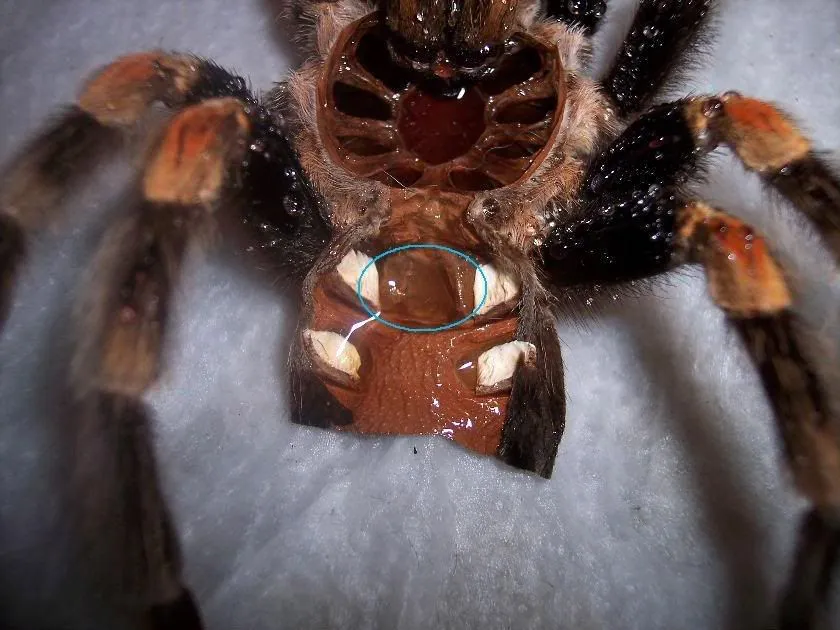What is a Male Tarantula Sperm Web?
The fascinating world of tarantulas includes a unique reproductive strategy that involves the construction of a specialized structure known as a sperm web. But what exactly is it? In essence, a sperm web is a small, silken mat that a male tarantula creates before mating. This web serves a critical role in the transfer of genetic material, acting as a platform for the male to deposit his sperm. This web isn’t just a simple sheet of silk; it’s a carefully constructed structure that facilitates the complex process of sperm transfer, a vital aspect of tarantula reproduction. The creation of this web is a clear indication of the male tarantula’s readiness to mate. It’s a fundamental part of their courtship ritual, signifying their biological imperative to propagate their genes and continue their lineage. This highlights the intricate behaviors that these creatures display, showcasing the sophistication that exists within the animal kingdom.
The Purpose of the Sperm Web
The primary function of the sperm web is to facilitate the transfer of sperm from the male tarantula to the female. Unlike mammals, male tarantulas don’t directly transfer sperm. Instead, they deposit their sperm onto this web. This web acts as a holding area and a transfer station for the sperm. The male tarantula then absorbs the sperm into specialized structures on his pedipalps, which are located near his mouth. These pedipalps are essentially the tarantula’s mating organs. The sperm is then stored within these organs, ready for the male to transfer it to the female tarantula during mating. Without the sperm web, the male would be unable to reproduce successfully, thus emphasizing the significance of this seemingly simple structure. Therefore, understanding the sperm web is paramount to grasping the intricacies of tarantula reproduction and the elaborate evolutionary adaptations within the arachnid world.
Why Male Tarantulas Build Sperm Webs

Male tarantulas build sperm webs for a very specific reason: to ensure successful reproduction. The entire process is meticulously orchestrated, and the web is a crucial component. The male tarantula creates the web and then deposits his sperm onto it. This external deposition is fundamentally different from internal fertilization methods seen in many other animals. The sperm, once deposited, is taken up by the male’s pedipalps, the structures resembling small legs located near the mouth. These pedipalps then act as delivery systems, carrying the sperm to the female during mating. This method is an evolutionary adaptation. Building a sperm web increases the chances of fertilization. It provides a controlled environment for sperm storage and transfer, enhancing reproductive success in the tarantula’s environment. It’s a complex, elegant solution to the challenges of reproduction, showcasing the sophistication of natural processes.
How to Identify a Sperm Web
Identifying a male tarantula’s sperm web can be an exciting task for any enthusiast or researcher. Sperm webs are generally small, flat, and disc-shaped structures made of fine silk. They often appear as a thin, slightly textured patch, distinct from the typical web spun for catching prey. Location is key. You typically find sperm webs near a male tarantula’s burrow or resting place, often in a sheltered area. The web’s presence indicates a male tarantula is ready to mate. Keep an eye out for these webs if you are looking to observe tarantula behavior. If you are observing tarantulas in captivity, the construction of a sperm web is usually a clear sign that the male is reaching maturity. The web’s appearance may vary slightly depending on the tarantula species, but its basic form is consistent. Learning to identify this web is important in understanding the tarantula’s life cycle and reproductive behavior.
Building Your Own Male Tarantula Sperm Web
While it’s impossible to make a tarantula sperm web in the same way a male tarantula does, you can create a simulation to understand the process. This isn’t about creating a functional web for reproduction, but rather about replicating the conditions and understanding the steps involved. It’s more about gaining insight into the process. This activity is a great way to appreciate the complexity of these creatures’ behaviors. Keep in mind that the actual creation of a sperm web is an instinctive behavior, controlled by hormones and evolution, so replicating it entirely is not feasible. This exercise focuses on understanding and replicating the process, not achieving the actual biological outcome. This process allows for a fascinating look into the intricacies of arachnid life, fostering appreciation for the natural world.
Materials Needed

To create your simulation, you’ll need a few simple materials. These aren’t meant to replicate the web itself, as that’s beyond our ability, but rather to mimic the environment in which the web is created. You’ll want a small, shallow container, such as a petri dish or a small plastic container. You’ll also need a piece of soft, fibrous material, like cotton wool or a paper towel, to act as a base. In addition, you’ll require a very fine, strong thread, or thin crafting wire, for simulating the web itself. This will help you visualize the structure. Finally, you can use a magnifying glass to examine the ‘web’ you create more closely and understand its structure. These materials will allow you to understand the key aspects of this interesting structure.
Step 1 Gathering Materials
The first step is to gather all the materials listed. Ensure you have everything ready before you start the simulation. This includes the container, base material, thread, and magnifying glass. Proper preparation helps in understanding the steps involved. It also ensures a smooth and organized experience. Check that your container is clean and dry, as this will be the ‘workspace’ for your simulated web. Also, cut the base material to fit the container’s dimensions. This will provide a suitable platform for your imitation web. Ensure you have plenty of thread available, as you’ll need enough to create a structure of the appropriate size. Having all these items ready streamlines the process. This preparation allows you to focus on the more engaging aspects of the simulation itself.
Step 2 Creating the Web
Now, start building your simulated sperm web. Place the base material inside the container. This will act as a ground for your imitation web. Next, begin to carefully lay down the thread, or crafting wire, across the base. Try to create a flat, circular shape, similar to the shape of a sperm web. You can use the magnifying glass to examine the structure as you build it. This way, you can understand the intricate, often complex patterns of real sperm webs. There’s no need for perfection here. It’s about attempting to mimic the structure. Try to lay the thread in a way that resembles a flat, disc-like shape. The aim is to build a platform similar to the one used by the tarantula. This exercise allows you to appreciate the skill and precision that go into creating these webs.
Step 3 Depositing Sperm

Since we are simulating, we cannot replicate the actual deposition of sperm. Instead, imagine that you are observing the process. This is where you can imagine the male tarantula placing its sperm onto the web. In the natural world, after the web is created, the male deposits his sperm onto it. This is usually a clear or slightly opaque fluid. For your simulation, you can visualize this process. Think about how the sperm would spread and adhere to the web’s surface. Consider how the male tarantula would position itself to deposit the sperm accurately. Appreciate the complexity of this biological process, and the role that the sperm web plays in enabling the reproductive process. This part of the exercise is all about visualizing and understanding the biological process rather than replicating it physically.
Step 4 Storing the Sperm
In the actual reproductive process, once the sperm is deposited, the male tarantula utilizes his pedipalps to collect it. Think about how the male tarantula would then use his pedipalps to absorb the sperm and store it. This storage allows the sperm to be transferred to the female during mating. It’s a complex process involving specialized organs and precise movements. As you consider the sperm web and its function, you’ll gain an even deeper appreciation for the elegance of nature’s reproductive strategies. This step emphasizes the role of the sperm web as a vital tool for the tarantula’s reproductive success. The web is important for the process of securing and storing sperm.
Tips for Success
When building your simulated sperm web, patience and observation are key. Take your time and carefully lay the thread to create a web-like structure. Use the magnifying glass to get a closer look at the details. This will help you appreciate the intricacies. Comparing your simulated web to images of real sperm webs can also provide insights. Remember, this is a simulation, so don’t worry if your web isn’t perfect. The goal is to understand the process, not to replicate it exactly. Learning about the tarantula’s behavior is also important. By studying the natural behavior of male tarantulas, you can gain a better understanding of why they build sperm webs. This simulation is an excellent way to appreciate the wonders of the natural world and the fascinating strategies used by tarantulas for reproduction.
Where to Find Information

To learn more about male tarantula sperm webs and tarantula reproduction, there are many resources available. Start with scientific journals and research papers to find accurate information. You can also explore online resources like university websites or entomology pages. These sources often provide detailed information on arachnids. Another option is to join online communities and forums dedicated to tarantulas. Members can share their experiences, observations, and knowledge. You will also find many books about tarantulas. This research can improve your knowledge of these fascinating creatures. Remember, seeking knowledge from reliable and scientific sources will provide you with the most accurate information. By exploring these resources, you can expand your understanding of the remarkable world of tarantulas and their reproduction.
